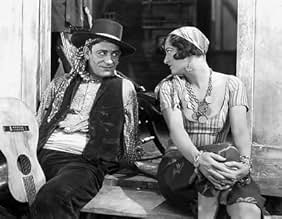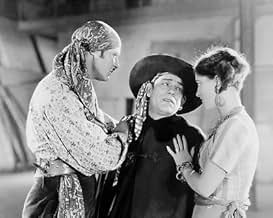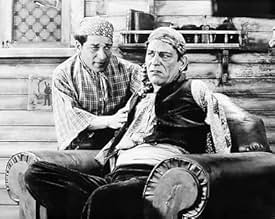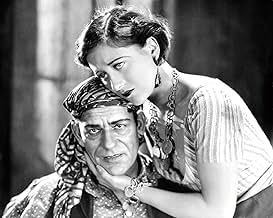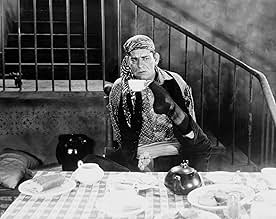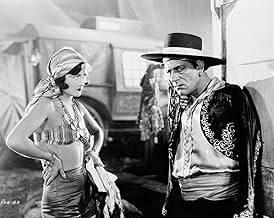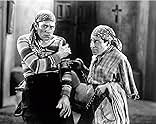AVALIAÇÃO DA IMDb
7,7/10
9,6 mil
SUA AVALIAÇÃO
Um atirador de facas, de grande sucesso num circo por não ter braços e usar os pés nos seus números, esconde um grande segredo.Um atirador de facas, de grande sucesso num circo por não ter braços e usar os pés nos seus números, esconde um grande segredo.Um atirador de facas, de grande sucesso num circo por não ter braços e usar os pés nos seus números, esconde um grande segredo.
- Prêmios
- 2 vitórias e 2 indicações no total
Tom Amandares
- Gypsy running to Zanzis Death Scene
- (não creditado)
Margaret Bert
- Fortune Teller
- (não creditado)
Louise Emmons
- Gypsy Woman
- (não creditado)
Italia Frandi
- Girl in Audience Flirting with Malabar
- (não creditado)
Venezia Frandi
- Woman in Audience
- (não creditado)
Polly Moran
- Landlady
- (não creditado)
- …
Julian Rivero
- Man in Theatre Audience
- (não creditado)
Billy Seay
- The Little Wolf
- (não creditado)
Dorothy Seay
- Spectator
- (não creditado)
John St. Polis
- Surgeon
- (não creditado)
- Direção
- Roteiristas
- Elenco e equipe completos
- Produção, bilheteria e muito mais no IMDbPro
Enredo
Você sabia?
- CuriosidadesJoan Crawford always considered "O Monstro do Circo (1927)" a big turning point for her. She said it wasn't until working with Lon Chaney in this film that she learned the difference between standing in front of a camera and acting in front of a camera. She said that was all due to Chaney and his intense concentration, and after that experience she said she worked much harder to become a better actress.
Chaney's performance certainly inspired co-star Crawford who wrote "Lon Chaney was my introduction to acting. The concentration, the complete absorption he gave to his characterization filled me with such awe I could scarcely speak to him...watching him have me the desire to be a real actress."
- Erros de gravaçãoMalabar pushes himself up off the bureau multiple times when talking to Nanon about flowers.
- Citações
Malabar the Mighty, Circus Strongman: There is a time for fear, Nanon... and a time for hate... and a time for love.
- Versões alternativasThe Turner library print has a commissioned score by the Alloy Orchestra and runs 49 minutes.
- ConexõesFeatured in Terror Universal (1998)
Avaliação em destaque
The Unknown is one of the more interesting Lon Chaney collaborations with director/writer Tod Browning, as Chaney's typically physically malleable performance is often executed here in conjunction with "stunt double" Peter Dismuki. It also features a great, early appearance by Joan Crawford, a complex, gripping, allegorically deep but economically told story by Browning, and it is an excellent instantiation of themes found throughout Chaney and Browning's other work. It even strongly presages Browning's 1932 film, Freaks.
Chaney is Alonzo the Armless, a performer in Antonio Zanzi's circus. Alonzo is in love with Nanon (Crawford), Antonio's daughter and Alonzo's assistant in his act, which consists of him using his feet to shoot guns and throw knives around Nanon with precision aim. In a typical Chaney film complicated love triangle, Nanon and Zanzi Circus strongman Malabar are also attracted to each other, but Nanon has an aversion to being touched and keeps distancing Malabar and any other man who wants to be intimate.
Alonzo is the perfect complement for Nanon then, since he cannot manhandle her. She feels safe with him. But Antonio objects to Alonzo's approaches towards Nanon. Complex confrontations and a number of fabulous twists ensue, and Chaney fans will likely expect the resultant profound tragedy with the reciprocally bittersweet "happy ending" consequences.
I probably made that synopsis sound more soap-operatic than it should, since it doesn't very well convey the overall twisted, creepy atmosphere that Browning achieves in The Unknown. Like Freaks, this isn't exactly a horror film, but it has all the unsettling, macabre attitude of one. Alonzo is one of Chaney's more demented, sinister characters, as almost every move he makes has a nefarious, ulterior motive. This even includes the reason that he joined the Zanzi Circus in the first place. It becomes quickly clear that Alonzo will stop at nothing to have Nanon all to himself. But because the character has no arms, he can't very well resort to physical bullying. Instead, Chaney paints a subversive and deviously manipulative character. Even the character's love for Nanon feels wicked--it's more of an unhealthy obsession than love.
Browning makes good use of his largely pared down sets and cast. Except for the opening circus scene, most of the film takes place among only four characters, in only a handful of circus wagon (used later for both Freaks and Chaney's 1928 film Laugh, Clown, Laugh) and apartment locations, with the ending, set in a theater, symmetrically reflecting the opening of the film. A single scene in a formal courtyard provides a nice, symbolic contrast, as does the use of the "extended technique" of a thin piece of gauze placed over the camera lens for some of Nanon's scenes.
Equally economical is Browning's complex story, which tells as much--with the aid of the performances--through implication of various backstories as it does through direct action. The (heavily allegorical) subtexts are fascinating. Nanon is frigid, so her most intimate relationship is with a man who has been effectively castrated. He is so obsessed with her that he'll physically sacrifice himself to enable a relationship. She secretly desires a normal love, but can't have one until she falls into it, or is tricked into it in a way. No one is quite honest with anyone else except for a man who is a relative simpleton, there to be manipulated. But he's the one who ends up coming out ahead, even though he never quite knows what is going on.
Browning had to construct a number of elaborate set-ups to produce the illusion that Chaney had been using his feet to do everyday activities for a long time. We often see Chaney's body but Peter Dismuki's feet, such as when Alonzo is playing guitar, smoking, drinking, and so on. Occasionally, Dismuki just stood in for Chaney, usually when Alonzo has his back to the camera, but at least in one wider shot, we can see Dismuki's face.
The 1997 score on the Turner Classic Movies version of the film by the Alloy Orchestra is occasionally excellent--especially during the climax of the film, and occasionally a bit pedestrian. When it's only pedestrian it's at least unobtrusive. The score has a modern, occasionally "rocky" feel that meshes surprisingly well.
There are a few scenes missing from the print transferred to the TCM DVD, but for many years, The Unknown was thought to have been lost, similar to Browning and Chaney's 1927 film London After Midnight. A print was found at the Cinémathèque Française, mixed in with a lot of other films marked "unknown" because the contents were (at least temporally) unidentifiable. The missing scenes do not hurt the coherency of the film, which is a must-see at least for any Chaney or Browning fans.
Chaney is Alonzo the Armless, a performer in Antonio Zanzi's circus. Alonzo is in love with Nanon (Crawford), Antonio's daughter and Alonzo's assistant in his act, which consists of him using his feet to shoot guns and throw knives around Nanon with precision aim. In a typical Chaney film complicated love triangle, Nanon and Zanzi Circus strongman Malabar are also attracted to each other, but Nanon has an aversion to being touched and keeps distancing Malabar and any other man who wants to be intimate.
Alonzo is the perfect complement for Nanon then, since he cannot manhandle her. She feels safe with him. But Antonio objects to Alonzo's approaches towards Nanon. Complex confrontations and a number of fabulous twists ensue, and Chaney fans will likely expect the resultant profound tragedy with the reciprocally bittersweet "happy ending" consequences.
I probably made that synopsis sound more soap-operatic than it should, since it doesn't very well convey the overall twisted, creepy atmosphere that Browning achieves in The Unknown. Like Freaks, this isn't exactly a horror film, but it has all the unsettling, macabre attitude of one. Alonzo is one of Chaney's more demented, sinister characters, as almost every move he makes has a nefarious, ulterior motive. This even includes the reason that he joined the Zanzi Circus in the first place. It becomes quickly clear that Alonzo will stop at nothing to have Nanon all to himself. But because the character has no arms, he can't very well resort to physical bullying. Instead, Chaney paints a subversive and deviously manipulative character. Even the character's love for Nanon feels wicked--it's more of an unhealthy obsession than love.
Browning makes good use of his largely pared down sets and cast. Except for the opening circus scene, most of the film takes place among only four characters, in only a handful of circus wagon (used later for both Freaks and Chaney's 1928 film Laugh, Clown, Laugh) and apartment locations, with the ending, set in a theater, symmetrically reflecting the opening of the film. A single scene in a formal courtyard provides a nice, symbolic contrast, as does the use of the "extended technique" of a thin piece of gauze placed over the camera lens for some of Nanon's scenes.
Equally economical is Browning's complex story, which tells as much--with the aid of the performances--through implication of various backstories as it does through direct action. The (heavily allegorical) subtexts are fascinating. Nanon is frigid, so her most intimate relationship is with a man who has been effectively castrated. He is so obsessed with her that he'll physically sacrifice himself to enable a relationship. She secretly desires a normal love, but can't have one until she falls into it, or is tricked into it in a way. No one is quite honest with anyone else except for a man who is a relative simpleton, there to be manipulated. But he's the one who ends up coming out ahead, even though he never quite knows what is going on.
Browning had to construct a number of elaborate set-ups to produce the illusion that Chaney had been using his feet to do everyday activities for a long time. We often see Chaney's body but Peter Dismuki's feet, such as when Alonzo is playing guitar, smoking, drinking, and so on. Occasionally, Dismuki just stood in for Chaney, usually when Alonzo has his back to the camera, but at least in one wider shot, we can see Dismuki's face.
The 1997 score on the Turner Classic Movies version of the film by the Alloy Orchestra is occasionally excellent--especially during the climax of the film, and occasionally a bit pedestrian. When it's only pedestrian it's at least unobtrusive. The score has a modern, occasionally "rocky" feel that meshes surprisingly well.
There are a few scenes missing from the print transferred to the TCM DVD, but for many years, The Unknown was thought to have been lost, similar to Browning and Chaney's 1927 film London After Midnight. A print was found at the Cinémathèque Française, mixed in with a lot of other films marked "unknown" because the contents were (at least temporally) unidentifiable. The missing scenes do not hurt the coherency of the film, which is a must-see at least for any Chaney or Browning fans.
- BrandtSponseller
- 5 de jun. de 2005
- Link permanente
Principais escolhas
Faça login para avaliar e ver a lista de recomendações personalizadas
- How long is The Unknown?Fornecido pela Alexa
Detalhes
- Data de lançamento
- País de origem
- Idiomas
- Também conhecido como
- The Unknown
- Locações de filme
- Empresa de produção
- Consulte mais créditos da empresa na IMDbPro
Bilheteria
- Orçamento
- US$ 217.000 (estimativa)
- Faturamento bruto mundial
- US$ 4.841
- Tempo de duração1 hora 8 minutos
- Cor
- Mixagem de som
- Proporção
- 1.33 : 1
Contribua para esta página
Sugerir uma alteração ou adicionar conteúdo ausente

Principal brecha
By what name was O Monstro do Circo (1927) officially released in India in English?
Responda
